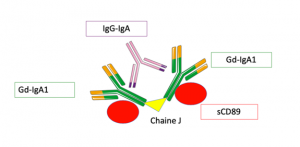Mentorship and Collaboration to Better Understand Childhood IgA Nephropathy

Alexandra CAMBIER, YNC member, associate professor of pediatric nephrology (MD-PhD), Sainte Justine Hospital, Montréal University
Université de Paris, Paris, France ; Centre de Recherche sur L’inflammation (CRI); INSERM U1149, Paris, France
IgA nephropathy (IgAN) is one of the most common forms of primary glomerulonephritis in children and adolescents worldwide [1]. In more than fifty percent of cases, patients with IgAN do not have any symptoms, and the diagnosis is made after an incidental finding of microscopic hematuria, hypertension, sub-normal glomerular filtration rate (GFR), or proteinuria [2-4]. Physicians have long considered childhood IgAN (cIgAN) a benign entity subject to remission and occasionally late relapse during adulthood [5]. Adult IgAN, on the other hand, is considered a serious manifestation, with 15–40% of patients reaching end-stage renal disease (ESRD), depending on the region [6]. However, the prognosis of cIgAN is just as severe as in adults: at ten-year follow-up, 10 to 13% of children will reach ESRD, and within 20 years, 20 to 30% will have ESRD [5, 7, 8].
A growing body of evidence suggests that IgAN is an immune complex-mediated glomerulonephritis resulting from the generation of IgA1 with aberrant glycosylation. Studies since the 1990s have revealed three key factors in the pathogenesis of IgAN, namely galactose-deficient IgA1 (Gd-IgA1), anti-IgA autoantibodies, and soluble IgA Fc receptor (sCD89) [9], (Figure 1).

These circulating immune complexes biomarkers have been identified as risk factors for adult IgAN progression but have not yet been characterized in cIgAN and could become targets for new therapies [10-13]. CIgAN differs from IgAN in that it presents as acute glomerulonephritis rather than chronic glomerulonephritis. Proteinuria in cIgAN is a marker of glomerular proliferative lesions, whereas its presence in adults often reflects chronic lesions [14, 15]. Since children have a long life expectancy, there is a need to describe more precisely the clinical particularities of cIgAN and find specific pathogenic factors for prognosis to elaborate treatment [16] targeting inflammatory processes and proliferative lesions in cIgAN. This requires extensive data collection and research collaboration.
The Young Nephrologists Committee, through its Research and Mentorship subcommittees, actively helps young ISN members develop their research careers and foster collaboration. The recently relaunched ISN Mentorship Program fosters expertise-sharing, expertise-building relationships, and project management in the field of nephrology and research for early-career nephrologists. Through this program, ISN members connect with the ISN global community to participate in program research, elaborate databases, and build mutual learning partnerships to raise understanding of the global nature of kidney health. This can be extremely useful for those working in rare diseases like childhood IgAN.
References
- Coppo R, Gianoglio B, Porcellini MG, Maringhini S (1998) Frequency of renal diseases and clinical indications for renal biopsy in children (report of the Italian National Registry of Renal Biopsies in Children). Group of Renal Immunopathology of the Italian Society of Pediatric Nephrology and Group of Renal Immunopathology of the Italian Society of Nephrology. Nephrol Dial Transplant 13:293-297.
- Cattran DC, Coppo R, Cook HT, Feehally J, Roberts IS, Troyanov S, Alpers CE, Amore A, Barratt J, Berthoux F, Bonsib S, Bruijn JA, D’Agati V, D’Amico G, Emancipator S, Emma F, Ferrario F, Fervenza FC, Florquin S, Fogo A, Geddes CC, Groene HJ, Haas M, Herzenberg AM, Hill PA, Hogg RJ, Hsu SI, Jennette JC, Joh K, Julian BA, Kawamura T, Lai FM, Leung CB, Li LS, Li PK, Liu ZH, Mackinnon B, Mezzano S, Schena FP, Tomino Y, Walker PD, Wang H, Weening JJ, Yoshikawa N, Zhang H, Society WGotIINNatRP (2009) The Oxford classification of IgA nephropathy: rationale, clinicopathological correlations, and classification. Kidney Int 76:534-545.
- Kamei K, Harada R, Hamada R, Sakai T, Hamasaki Y, Hataya H, Ito S, Ishikura K, Honda M (2016) Proteinuria during Follow-Up Period and Long-Term Renal Survival of Childhood IgA Nephropathy. PLoS One 11:e0150885.
- Coppo R (2017) Clinical and histological risk factors for progression of IgA nephropathy: an update in children, young and adult patients. Journal of nephrology 30:339-346.
- Wyatt RJ, Kritchevsky SB, Woodford SY, Miller PM, Roy S, 3rd, Holland NH, Jackson E, Bishof NA (1995) IgA nephropathy: long-term prognosis for pediatric patients. The Journal of pediatrics 127:913-919.
- Radford MG, Jr., Donadio JV, Jr., Bergstralh EJ, Grande JP (1997) Predicting renal outcome in IgA nephropathy. J Am Soc Nephrol 8:199-207.
- Hastings MC, Delos Santos NM, Wyatt RJ (2007) Renal survival in pediatric patients with IgA nephropathy. Pediatric nephrology 22:317-318.
- Ronkainen J, Ala-Houhala M, Autio-Harmainen H, Jahnukainen T, Koskimies O, Merenmies J, Mustonen J, Ormala T, Turtinen J, Nuutinen M (2006) Long-term outcome 19 years after childhood IgA nephritis: a retrospective cohort study. Pediatr Nephrol 21:1266-1273.
- Robert T, Berthelot L, Cambier A, Rondeau E, Monteiro RC (2015) Molecular Insights into the Pathogenesis of IgA Nephropathy. Trends Mol Med 21:762-775.
- Berthoux F, Suzuki H, Thibaudin L, Yanagawa H, Maillard N, Mariat C, Tomino Y, Julian BA, Novak J (2012) Autoantibodies targeting galactose-deficient IgA1 associate with progression of IgA nephropathy. J Am Soc Nephrol 23:1579-1587.
- Vuong MT, Hahn-Zoric M, Lundberg S, Gunnarsson I, van Kooten C, Wramner L, Seddighzadeh M, Fernström A, Hanson L, Do LT, Jacobson SH, Padyukov L (2010) Association of soluble CD89 levels with disease progression but not susceptibility in IgA nephropathy. Kidney Int 78:1281-1287.
- Berthelot L, Robert T, Vuiblet V, Tabary T, Braconnier A, Drame M, Toupance O, Rieu P, Monteiro RC, Toure F (2015) Recurrent IgA nephropathy is predicted by altered glycosylated IgA, autoantibodies and soluble CD89 complexes. Kidney Int 88:815-822.
- Berthelot L, Papista C, Maciel TT, Biarnes-Pelicot M, Tissandie E, Wang PH, Tamouza H, Jamin A, Bex-Coudrat J, Gestin A, Boumediene A, Arcos-Fajardo M, England P, Pillebout E, Walker F, Daugas E, Vrtosvnik F, Flamant M, Benhamou M, Cogné M, Moura IC, Monteiro RC (2012) Transglutaminase is essential for IgA nephropathy development acting through IgA receptors. J Exp Med 209:793-806.
- Cambier A, Rabant M, El Karoui K, Peuchmaur M, Servais A, Hertig A, Deschenes G, Salomon R, Hogan J, Robert T (2020) Clinical and histological differences between adults and children in new onset IgA nephropathy. Pediatr Nephrol.
- Cambier A, Rabant M, Peuchmaur M, Hertig A, Deschenes G, Couchoud C, Kolko A, Salomon R, Hogan J, Robert T (2018) Immunosuppressive Treatment in Children With IgA Nephropathy and the Clinical Value of Podocytopathic Features. Kidney Int Rep 3:916-925.
- Cambier A, Gleeson PJ, Flament H, Le Stang MB, Monteiro RC (2020) New therapeutic perspectives for IgA nephropathy in children. Pediatr Nephrol.













